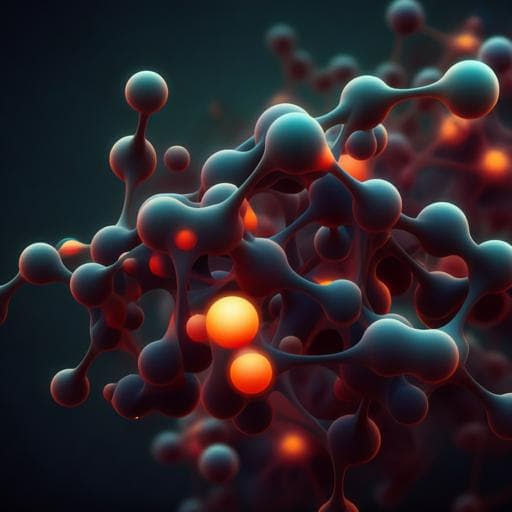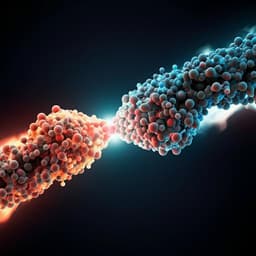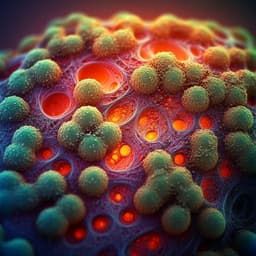
Chemistry
Catalytic nanosponges of acidic aluminosilicates for plastic degradation and CO<sub>2</sub> to fuel conversion
A. Maity, S. Chaudhari, et al.
This innovative research reveals the synthesis of amorphous acidic aluminosilicates (AAS), exhibiting extraordinary catalytic performance, outperforming traditional zeolites and aluminosilicates in transforming waste plastics to hydrocarbons and CO2 to fuel. Discover the molecular-level insights into their acidity, as presented by Ayan Maity and colleagues.
~3 min • Beginner • English
Introduction
Solid acids are vital heterogeneous catalysts due to their tunable acidity, recyclability, and stability, offering greener alternatives to liquid acids. Crystalline zeolites possess strong Brønsted acidity but suffer from diffusion limitations due to intrinsic microporosity, especially for reactions with bulky molecules. Mesoporous zeolites have been explored to mitigate diffusion constraints but face phase separation and stability issues. Amorphous aluminosilicates (ASAs) provide mesoporosity and accessibility but typically have weaker acidity and moderate stability. The acidity origins differ: zeolites have bridging silanols with tetra-coordinated Al(IV) closely interacting with Si–OH (O–Al distances ~1.8–2.0 Å), whereas ASAs feature pseudo-bridging silanols with longer O–Al distances (2.94–4.43 Å), leading to weaker acidity. The study addresses whether amorphous materials can host zeolite-like bridging silanol sites while retaining mesoporosity, aiming to create solid acids that combine strong Brønsted acidity with high accessibility for improved catalysis, plastic degradation, and CO2-to-fuel conversion.
Literature Review
Prior work highlights trade-offs between acidity and accessibility in solid acids. Zeolites provide strong Brønsted acid sites (bridging silanols) but are diffusion-limited; mesoporous zeolites partially alleviate this but face stability and phase-separation challenges. Conventional ASAs are mesoporous but their acidity arises from pseudo-bridging silanols involving Al(IV)/Al(V), typically weaker than zeolitic Brønsted sites. Reports suggest increasing Brønsted acidity in silica–alumina composites up to zeolitic strength, and that penta-coordinated aluminum can contribute to Brønsted acidity. Dynamic nuclear polarization (DNP) surface-enhanced NMR has enabled atomic-level insights into aluminosilicate interfaces and acid sites. Hierarchical and seed-assembled materials (e.g., Meso-MFI, SAM) provide benchmarks for combining acidity with mesoporosity. However, the existence of amorphous materials bearing true zeolite-like bridging silanols remains debated. This work builds on these foundations to design AAS that demonstrate zeolitic Brønsted sites within an amorphous, mesoporous nanosponge architecture.
Methodology
Synthesis of AAS: A soft-templating, bicontinuous microemulsion approach was used to hetero-condense TEOS with aluminum precursors to favor Si–Al condensation over homo-condensation. Two Al precursors with differing hydrolysis rates were employed: aluminum acetylacetonate (Al-AC) and aluminum isopropoxide (Al-IP). CTAB served as surfactant and 1-pentanol as cosurfactant to generate lamellar phases leading to nanosponge morphology. Representative synthesis: CTAB (500 mg) and urea (600 mg) in water (5 mL) stirred 30 min; a solution of TEOS and Al precursor in p-xylene (45 mL; amounts per Table 2) added dropwise and stirred 30 min; 1-pentanol (1.5 mL) added dropwise, stirred 30 min; reflux at 120 °C for 12 h; isolate by centrifugation; wash (ethanol ×4, water ×3, ethanol); dry at 80 °C overnight; calcine in air at 750 °C (5 °C min−1) for 6 h to remove CTAB. Samples: AC*-1.9 (no cosurfactant), AC-1.9, AC-9, AC-1.3 (all with Al-AC), IP-0.3 and IP-2.8 (with Al-IP). Example reagent amounts (mmol): AC*-1.9: TEOS 2.8, Al-precursor 2.8; AC-1.9: TEOS 2.8, Al 2.8; AC-9: TEOS 53, Al 0.3; AC-1.3: TEOS 1.9, Al 3.7; IP-0.3: TEOS 2.8, Al 2.8; IP-2.8: TEOS 5.4, Al 1.0.
Characterization: SEM/TEM (HAADF) for morphology (nanosponge nanoparticles); N2 sorption (BET surface area 436–588 m2 g−1; BJH pore volume 0.7–1.5 cm3 g−1; broad pore sizes up to ~25 nm); EDX for Si/Al and mapping (homogeneous Al); PXRD/SAED (amorphous; minor alumina domains only in IP-0.3); 27Al MAS NMR (Al(IV), Al(V), Al(VI) populations; quadrupolar coupling constants); 1H MAS NMR (silanol and Al–OH protons); DNP-enhanced 1H–27Al HETCOR (contact time 0.4 ms) to evidence proximity of H to Al indicative of bridging silanols; TGA for hydroxyl density (5.4–13 OH nm−2 via Boer equation); NH3-TPD (acid strength distribution); DRIFTS of adsorbed pyridine (Brønsted bands at 1546 and 1638 cm−1); pyridine poisoning during m-xylene isomerization to quantify BAS (~225 μmol g−1).
Catalytic probe reactions and conditions: (i) Styrene oxide ring-opening by methanol: evaluate overall acidity without diffusion limitations; conversions monitored up to 6 h. (ii) Vesidryl synthesis (2′,4,4′-trimethoxychalcone) from 2,4-dimethoxy acetophenone and p-anisaldehyde at 150 °C (1 h and 24 h) and 120 °C (4–8 h); activation vs no activation compared. (iii) Friedel–Crafts alkylation of anisole with benzyl alcohol: benchmark at 160 °C (microwave, literature) and in this work at 120 °C, 10 mg catalyst, 3 h; also 90 °C tests to exclude Lewis acidity. (iv) Jasminaldehyde synthesis (benzaldehyde + heptanal) at 125 °C; also at 100 °C; activation vs no activation compared. (v) m-Xylene isomerization at 300 °C; product distribution quantified; pyridine poisoning to determine BAS density. (vi) Cumene cracking; conversion compared against ASAs. Comparative catalysts synthesized or procured: Meso-MFI-Zeolite, ZSM-5, ASA-2, ASA (5/95, cogel), ASA-2 (1073), SAM, Al-MCM-41, DFNS.
Plastic pyrolysis: Thermogravimetric analysis under N2 (70 mL min−1), heating 250–550 °C at 10 °C min−1. LDPE (6 mg, 500 μm, 0.92 g cm−3) mixed with AAS (typ. 2 mg; varied 0.5–6 mg). T5/T20/T50 determined. Substrates: LDPE, HDPE (carry bag), polypropylene (centrifuge tube), PET (bottle). Recyclability assessed over 27 cycles; regeneration by oxygen treatment to remove coke.
CO2-to-DME: Fixed-bed reactor (i.d. 9 mm), 500 mg bifunctional catalyst by physical mixing AAS (200 mg) with Cu-Zn-Al (300 mg). Feed: CO2:H2:N2 = 5:15:5 mL min−1 (CO2:H2 = 1:3), 30 bar, 260 °C, GHSV 3000 mL h−1 g−1 (varied to 1500). Online GC (TCD for CO2/CO/N2; FID for hydrocarbons). Stability tested up to 150 h.
Key Findings
- Materials: AAS nanosponges combine strong Brønsted acidity with mesoporosity (BET up to 588 m2 g−1; pore volume up to 1.5 cm3 g−1; pores up to ~25 nm). AC*-1.9 exhibited the most open structure; Al content depended on precursor hydrolysis (AC*-1.9 ~15 wt% Al; IP-0.3 ~34 wt% Al).
- Catalysis evidencing strong BAS and accessibility:
• Styrene oxide ring-opening: AC*-1.9 and AC-1.9 showed highest conversions among AAS; IP-0.3 lowest, indicating weaker acidity despite higher total Al.
• Vesidryl synthesis: At 150 °C, 1 h: AC*-1.9 62% vs Meso-MFI 58%; 24 h: AC*-1.9 79% vs Meso-MFI 66% vs ZSM-5 45%. At 120 °C, 4 h: AC*-1.9 60%, AC-1.9 40%, AC-9 28%, AC-1.3 38%, IP-0.3 5%. Without activation at 150 °C, 1 h: AC*-1.9 41% vs Meso-MFI 24%.
• Friedel–Crafts alkylation (120 °C, 10 mg catalyst, 3 h): AC*-1.9 ~94% conversion; Meso-MFI ~70%; ZSM-5, IP-0.3, IP-2.8, ASA-2 ~negligible. At 90 °C, results confirm Brønsted (not Lewis) acidity is responsible.
• Jasminaldehyde synthesis: AC*-1.9 reached 88% conversion in 6 h at 125 °C, comparable to Meso-MFI; activity maintained without activation and even at 100 °C.
• m-Xylene isomerization (300 °C): AC*-1.9 18% conversion; Meso-MFI ~29%; ZSM-5 9%. BAS quantified by pyridine poisoning at ~225 μmol g−1 for AC*-1.9. Product distribution included p-xylene, toluene, trimethylbenzene isomers.
• Cumene cracking: AC*-1.9 ~70% conversion vs conventional ASAs <20%.
- Spectroscopic/acid-site characterization:
• 27Al MAS NMR: AC series enriched in Al(IV)/Al(V); Al(VI) higher in IP-0.3. AC series showed larger quadrupolar couplings for Al(IV) (12–13 MHz) vs typical ASAs (~6 MHz), closer to zeolites (~15 MHz), indicating zeolite-like environments.
• 1H MAS NMR: Additional sharp resonance at ~2.8 ppm (and broader at ~2.4 ppm) observed in AC series, absent in IP-0.3, consistent with bridging silanols near Al.
• DNP-enhanced 1H–27Al HETCOR (0.4 ms contact): Cross-peaks at (58–63 ppm 27Al, 2.8–3.0 ppm 1H) in AC samples (not in IP-0.3), characteristic of Brønsted bridging silanol sites; highest intensity for AC*-1.9 correlating with superior catalysis.
• NH3-TPD: Strong acid desorption peaks for AC series at ~400 °C and ~560 °C; IP-0.3 peaks at lower temperatures (~360 °C, ~520 °C). H-ZSM-5 shows ~400 °C peak (bridging silanol), aligning with AAS behavior. DRIFTS-pyridine showed Brønsted bands at 1546 and 1638 cm−1.
- Plastic pyrolysis (TGA): AAS significantly lowered LDPE degradation temperatures. AC*-1.9 achieved T50 ≈ 335 °C with 2 mg catalyst per 6 mg LDPE; optimized catalyst loading reduced T50 to 325 °C. DFNS (non-acidic) showed no catalytic effect. Real plastics: T50 reduced from 454→323 °C (polypropylene falcon tube), 475→360 °C (HDPE bag), 439→403 °C (PET bottle). Recyclability: T50 increased from 345→382 °C by cycle 15 due to coke; restored to 351 °C after oxygen treatment; stable up to 27 cycles with minor deactivation.
- Comparison to benchmarks: AC*-1.9 outperformed USY-2.6 (T50 341 °C) and other solid acids; lower T50 than Meso-MFI (~350 °C) for LDPE pyrolysis.
- CO2-to-DME (Cu–Zn–Al/AAS): CO2 conversion 15–19%; DME selectivity highest with AC*-1.9/AC-1.9 (~68% at GHSV 3000 mL h−1 g−1), increased to 79% at GHSV 1500. Cu–Zn–Al/DFNS produced no DME. Stability: ~20% decrease in DME selectivity after 150 h on stream at 260 °C, 30 bar. AC-1.9 showed better CO2 conversion than Meso-MFI; ZSM-5 and ASA-2 had poor DME selectivity.
Discussion
The AAS synthesized via microemulsion templating integrate zeolitic-strength Brønsted acid sites with mesoporous accessibility. Catalytic probes spanning small to bulky substrates show that AC series AAS deliver both strong acid-catalyzed activity (e.g., vesidryl, Friedel–Crafts, jasminaldehyde, cumene cracking) and improved kinetics due to accessible nanosponge morphology, outperforming meso-zeolites and conventional ASAs in reactions requiring both strong acidity and mesoporosity. For smaller molecules where diffusion is less limiting (m-xylene isomerization), meso-zeolites can outperform AAS, underscoring the role of pore architecture for specific transformations.
Spectroscopic evidence (27Al MAS NMR with high quadrupolar couplings for Al(IV), 1H signatures at ~2.8 ppm, DNP 1H–27Al HETCOR cross-peaks, NH3-TPD, pyridine-DRIFTS) collectively confirms the presence of zeolite-like bridging silanol BAS in amorphous AAS, particularly abundant in AC*-1.9. The choice of Al precursor (Al-AC vs Al-IP) governs hydrolysis/condensation kinetics, promoting efficient Si–Al hetero-condensation and formation of bridging silanols in AC-based AAS; IP-based AAS, despite higher total Al, show weaker acidity due to different acid site nature.
Applications demonstrate societal relevance: AAS lower plastic pyrolysis temperatures by up to ~100 °C and are regenerable via oxidative treatment; in bifunctional CO2 hydrogenation, AAS provide the acid function enabling high DME selectivity (up to 79%) with moderate stability. Overall, AAS bridge the gap between crystalline zeolites and amorphous aluminosilicates by combining strong Brønsted acidity with high accessibility.
Conclusion
This work introduces amorphous acidic aluminosilicate nanosponges (AAS) that uniquely combine zeolite-like Brønsted acidity with mesoporous textural properties. Through multiple catalytic benchmarks and advanced solid-state NMR (including DNP-enhanced HETCOR), the presence of zeolitic bridging silanol BAS in AAS is established. AAS outperform state-of-the-art zeolites and ASAs in reactions requiring both strong acidity and accessibility, effectively catalyze plastic degradation at significantly reduced temperatures, and, as part of bifunctional hybrids with Cu–Zn–Al, enable CO2-to-DME conversion with selectivity up to 79%.
These materials offer a practical alternative to zeolites for bulky-molecule transformations and environmental applications. Future directions include: tuning Si/Al ratios and precursor chemistry to further optimize BAS density and distribution; tailoring pore architectures for specific reactions; improving long-term stability and coke resistance under continuous operation; and scaling synthesis while maintaining uniformity of acid sites.
Limitations
- Catalyst performance depends on Al precursor: materials synthesized with Al-isopropoxide (IP-0.3) showed weaker acidity and poorer catalytic performance despite higher total Al content, indicating sensitivity to synthesis conditions.
- Diffusion effects remain reaction-dependent: for small-molecule isomerization (m-xylene), meso-zeolites outperformed AAS, highlighting that AAS may not be optimal for all acid-catalyzed reactions.
- Deactivation by coke during plastic pyrolysis necessitated oxidative regeneration; while reversible, it indicates susceptibility to carbon deposition over cycles.
- In CO2-to-DME, selectivity declined by ~20% after 150 h on stream, indicating moderate stability under continuous operation.
- Minor crystalline alumina domains were observed in IP-0.3 (by TEM), and materials are amorphous overall; structural heterogeneity could impact site uniformity and reproducibility.
- Most evaluations used model reactions and TGA-based pyrolysis; comprehensive process-scale assessments and product speciation from plastic pyrolysis were not detailed here.
Related Publications
Explore these studies to deepen your understanding of the subject.







